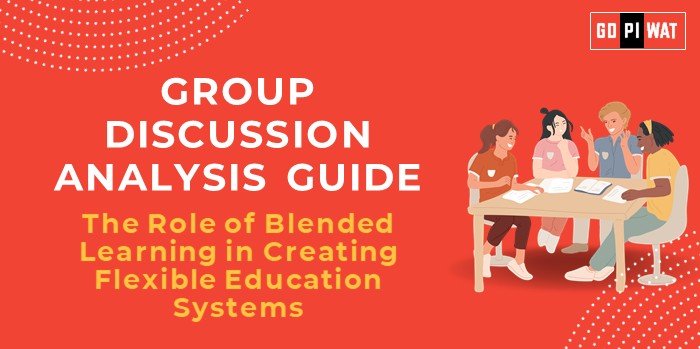📋 Group Discussion (GD) Analysis Guide: The Role of Blended Learning in Creating Flexible Education Systems
🌐 Introduction to the Topic
Opening Context: “Blended learning is transforming education by combining traditional classroom methods with digital tools, ensuring adaptability in a rapidly evolving world.”
Background: Blended learning emerged from the increasing demand for personalized education and technological advancements. It gained prominence during the COVID-19 pandemic as schools and universities adapted to remote and hybrid models.
📊 Quick Facts and Key Statistics
- Global EdTech Market Value: $254 billion (2023) – Highlights rapid adoption of technology in education.
- E-learning Engagement Growth: 200% increase since 2020 – Reflects a shift towards digital learning.
- Digital Infrastructure in Schools: 68% globally – Underlines access disparities.
- Blended Learning Effectiveness: 25% improvement in retention rates – Demonstrates pedagogical advantages.
👥 Stakeholders and Their Roles
- Government Agencies: Implement policies, allocate resources, and set digital standards.
- Educational Institutions: Redesign curricula to integrate blended learning.
- EdTech Companies: Develop tools and platforms to facilitate blended learning.
- Students and Parents: Engage actively with the blended learning framework for better outcomes.
- NGOs and International Organizations: Bridge gaps in digital access and provide training.
🏆 Achievements and Challenges
📈 Achievements:
- Improved accessibility to education in remote areas.
- Increased student engagement with interactive tools.
- Enhanced teacher training programs for digital proficiency.
⚠️ Challenges:
- Digital divide in underprivileged regions.
- Resistance to adopting new methods among educators and institutions.
- Data security concerns with digital platforms.
🌍 Global Comparisons:
- Finland: Seamless integration of technology into education.
- India: Limited but growing success with initiatives like PM e-Vidya.
📚 Case Study:
Kerala, India: Introduced digital education platforms during the pandemic, achieving over 90% student participation.
💡 Structured Arguments for Discussion
- Supporting Stance: “Blended learning bridges traditional and modern education, fostering inclusivity and adaptability.”
- Opposing Stance: “It risks widening educational inequalities due to uneven digital access.”
- Balanced Perspective: “Blended learning offers potential but requires robust infrastructure and policy support.”
✨ Effective Discussion Approaches
- Opening Approaches:
- “Blended learning improved retention by 25%, showcasing its educational value.”
- “The digital divide challenges the inclusive implementation of blended learning.”
- Counter-Argument Handling:
- Acknowledge gaps in access but highlight long-term cost reductions.
- Suggest partnerships for bridging technological divides.
📈 Strategic Analysis of Strengths and Weaknesses
- Strengths: Increases access, enables personalized learning.
- Weaknesses: Requires substantial investment, limited in low-tech areas.
- Opportunities: Integration with AI and data analytics.
- Threats: Cybersecurity risks, potential misuse of technology.
🎓 Connecting with B-School Applications
- Real-World Applications: Strategy formulation for education startups, operational improvements in EdTech.
- Sample Interview Questions:
- “How can blended learning impact rural education in developing countries?”
- “What role can AI play in optimizing blended learning systems?”
- Insights for Students: Blended learning innovations can inspire project ideas in social entrepreneurship and technology management.


